PRINCETON, NJ -- Gallup's Job Creation Index hit +11 in November -- its best reading since September 2008 -- with job creation highest in the Midwest, at +15, and lowest in the West, at +5.
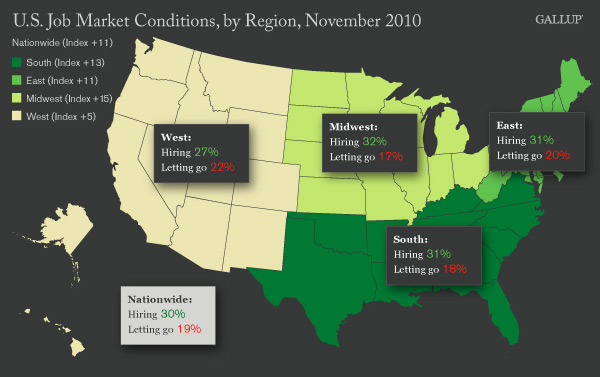
The results, from Gallup Daily tracking, are based on 15,163 U.S. employees' self-reports of hiring and firing activity at their workplaces.
Hiring and Letting Go Have Each Improved Nationwide
The 30% of workers nationwide who report their employer is hiring and the 19% who say their employer is letting people go represent an improvement from job market conditions in January, when 23% of firms were hiring and 24% were firing. Current job market conditions nationwide are also better than the +2 of November 2009 and the +6 of November 2008. However, they remain far worse than the +26 of January 2008 -- the point at which the recession was just getting underway.
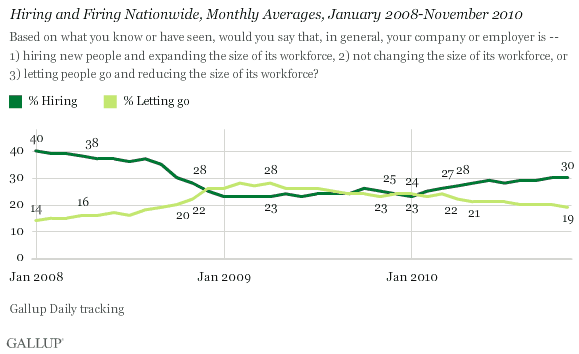
Midwest Is Best and Improving
Hiring in the Midwest increased to 32% in November and firing fell to 17%, improving the region's Job Creation Index to +15 from +11 in October. This reflects both the largest increase and the best job-creation conditions of any region. Continued improvements in the manufacturing sector as well as for farm and other commodities have produced a sharp rise in job market conditions in this region from the +1 hiring-firing gap of November 2009 and the +2 of November 2008.
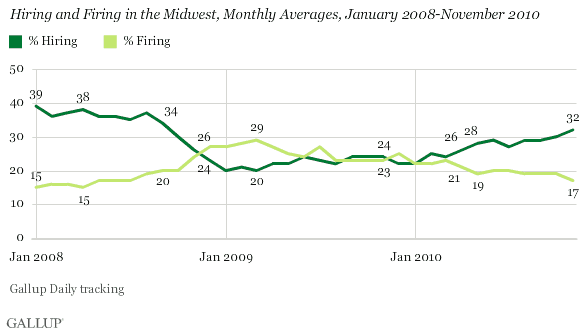
South Job Market Nearly as Good
Job conditions in the South are nearly as good as those in the Midwest, with hiring at 31% and firing declining to 18%. The region's Job Creation Index is +13, matching its best of the year and otherwise its highest reading since October 2008. The recent improvement of job conditions in the South may reflect some recovery from the effects of the BP oil spill and the continuing growth of U.S. exports.
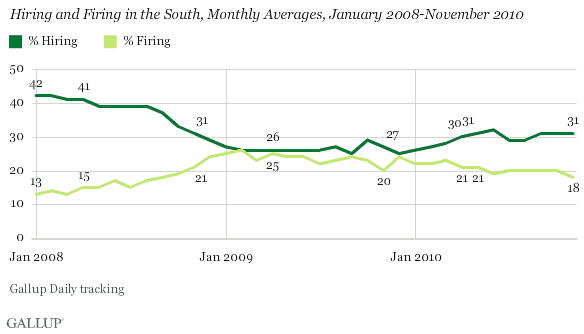
East Is Stable at Best Level Since September 2008
In the East, 31% of employers have been hiring and 20% letting employees go for the past three months, for an index that matches the current national average of +11. Although stable, job market conditions here remain at their best since September 2008 and appear to reflect a return to stability on Wall Street as well as in the U.S. financial sector.
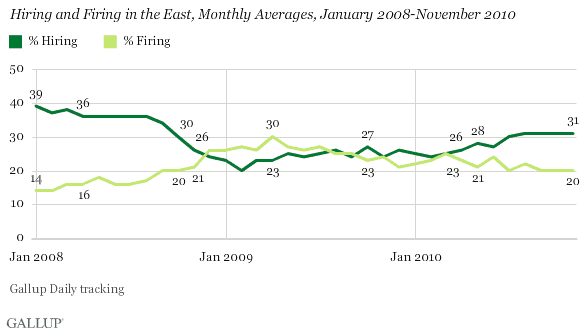
West Shows Stability but Trails Other Regions
Hiring and firing activity in the West continues to trail that of other regions, with 27% of companies hiring and 22% letting employees go, for an index of +5. The job market in the West has not improved since summer and may reflect some of the worst housing and real estate market conditions in the U.S.

Commentary
Employees nationwide report hiring and firing activity at their places of work that is the best it has been since September 2008. This stands in sharp contrast to the impression the government's unemployment report gave on Friday -- but is consistent with Gallup's unemployment and underemployment measures. While much of today's job creation may be seasonal, involving the holidays, and therefore may not be reflected in the government's unemployment report, any improvement in job market conditions benefits those needing work and today's fledgling economic recovery.
Still, the U.S. job situation remains far worse than it was in January 2008, as the recession was getting underway. It appears as though the Congress will act to extend the Bush tax cuts and continue the extended unemployment benefits, and this could help improve things further.
While jobs need to remain the primary policy focus during the months ahead, Gallup's unemployment and job creation data suggest new jobs are being created at the best rate in more than two years -- an encouraging finding for everyone looking for a job in today's tough job market.
Gallup.com reports results from these indexes in daily, weekly, and monthly averages and in Gallup.com stories. Complete trend data are always available to view and export in the following charts:
Daily: Employment, Economic Confidence and Job Creation, Consumer Spending
Weekly: Employment, Economic Confidence, Job Creation, Consumer Spending
Read more about Gallup's economic measures.
View our economic release schedule.
Survey Methods
For Gallup Daily tracking, Gallup interviews approximately 1,000 national adults, aged 18 and older, each day. The Gallup Job Creation Index results are based on a random sample of approximately 500 current full- and part-time employees each day.
National results for November are based on Gallup Daily tracking interviews with 15,163 employees. For this sample, one can say with 95% confidence that the maximum margin of sampling error is ±1 percentage point. Regional results for August are based on interviews totaling more than 3,000 in each region. For each total regional sample, the maximum margin of sampling error is ±3 percentage points.
Interviews are conducted with respondents on landline telephones and cellular phones, with interviews conducted in Spanish for respondents who are primarily Spanish-speaking. Each daily sample includes a minimum quota of 150 cell phone respondents and 850 landline respondents, with additional minimum quotas among landline respondents for gender within region. Landline respondents are chosen at random within each household on the basis of which member had the most recent birthday.
Samples are weighted by gender, age, race, Hispanic ethnicity, education, region, adults in the household, cell phone-only status, cell phone-mostly status, and phone lines. Demographic weighting targets are based on the March 2009 Current Population Survey figures for the aged 18 and older non-institutionalized population living in U.S. telephone households. All reported margins of sampling error include the computed design effects for weighting and sample design.
In addition to sampling error, question wording and practical difficulties in conducting surveys can introduce error or bias into the findings of public opinion polls.
For more details on Gallup's polling methodology, visit www.gallup.com.
